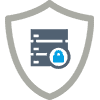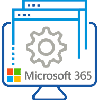Managing Complex Systems
Users, including remote users, need to be able to rely on a robust, secure infrastructure that’s available anywhere and at any time. The growing need for storage space, fast information processing and the multiplication of data access modes means the management of IT systems is increasingly complex.
Nowadays, many companies host their critical business data and applications themselves, but because they face significant associated costs to cover personnel, resources, IT investment and maintenance, outsourcing is a much better option.
Outsourcing data hosting and IT systems effectively allows companies to concentrate on their core business and to be confident about data integrity.
It is therefore important to rely on a qualified partner who can support your company’s cloud computing projects in the long term.
Tailor-Made Hosting Solutions
Colocation services, disaster recovery and business continuity projects, virtual machine (VM) IaaS hosting, SaaS solutions such as Microsoft® software suites, are all services offered by Sonema to ensure the reliability, flexibility and security of your information system within our high-availability datacentre.
Outsourcing your hosting to Sonema’s team of experts guarantees that you will benefit from high-performance facilities while improving productivity.
Sonema offers scalable hosting solutions based on robust connectivity and high-performance security solutions.
Benefits
Predictable Costs
- Pay-as-you-grow billing
- Optimisation of licences and cloud services
- All Inclusive: no hidden costs or investments
Tailor-Made Offers
- Customised hybrid architectures
- Dedicated capacity as and when needs change
- Access to disaster recovery and business continuity solutions
Access to Dedicated Facilities
- Private data center with redundancy
- Tier-III design – PCI-DSS certified
Discover Our Hosting and Cloud Services

Housing
Rack rental, private rooms and redundant equipments (power, air conditioning, feed…)

Virtual Servers
A cloud computing service which uses virtual machines (VM) to provide the very highest levels of security.

Save & Restore
An outsourced backup service to secure and restore data in case of disaster.
BCP/DRP
The best service to protect your data and ensure your business continuity.

M365 Cloud Solutions
Improve productivity with the help of our experts in managing your Microsoft 365 Cloud solutions.

Electronic Signature
Dematerialise, sign and manage your documents in a few clicks!
Frequently Asked Questions
What is the difference between Housing and Hosting?
What is virtualisation?
What is a VM (Virtual Machine)?
What are vRAM, vCPU, and vDisk?
vCPU: is the sum of VCPUs allocated to VMs in order to treat the data and execute applications sent by the vRAM.
vDisk is the total sum of disk space provisioned to VMs on which the host or an application can carry out reading and writing operations.
What is a PCI-DSS Datacentre?
How are datacentre tiers classified?
99.671% for a Tier I datacentre to 99.995% for a Tier IV datacentre. The Sonema Level III datacentre comprises a server network, storage spaces, network connections and other redundant and dual-power IT components ensuring a level of availability of 99.982% or 1.6 hours of service interruption per year (on average).
| Criteria | Tier-III |
|---|---|
| Rate of Availability | 99.98 % |
| On-line Maintenance | Yes |
| Power Distribution | N + 1 |
| Dual Power | Yes |
| Cooling Circuit | N + 1 |
| Dual Secured End-to-End Fibre | Yes |
What is Cloud Computing?
What are the various cloud components?
- SaaS (Software as a Service): provision of business applications: CRM, collaborative tools, email, Business Intelligence, ERP etc. The operator operates and oversees all technical aspects of the software for the customer’s account.
- PaaS (Platform as a Service): provides a middleware platform allowing customers to develop, run, and manage applications. The operator monitors and controls the technical infrastructure (network, servers, OS, storage etc while the customer has control over application deployment and configuration.
- IaaS (Infrastructure as a Service): provision of IT resources: CPU power, memory, storage etc. The IaaS model allows the customer to use virtual and remote resources whilst keeping control of the OS, storage and applications in addition to some network elements (for example the firewall).
Sonema offers all of these services within the scope of its hosting offer.
What is the USA Patriot Act?
signed into law by President George W. Bush in 2001. It authorises law enforcement authorities to access IT data held by individuals and American businesses, without a court order and without informing the users.
What is the Cloud Act?
| Patriot Act | Cloud Act | |
|---|---|---|
| Date | October 26th, 2001 | March 23rd, 2018 |
| Beneficiaries | American governmental agencies (FBI, CIA, NSA, Army) | American authorities with a warrant |
| Field | Terrorism | Criminal investigations |
| Context | Terrorism investigations | Criminal investigations |
| Target | American businesses and their foreign subsidiaries | |
| Nationality of subject | American citizen or foreigner | |
| Location of data | USA or abroad | |
Sonema’s customer data is exclusively hosted in the Frejus or Lognes datacentre which are owned by Sonema and are located in France. This enables us to ensure data confidentiality without being subject to the Cloud Act.
What is Webmail?
What is Post Office Protocol?
What is IMAP (Internet Message Access Protocol)?
What is SMTP (Simple Mail Transfer Protocol)?
What is an email client?
What is DAG (Database Availability Group)?
What are the benefits of hosting mailboxes within a dedicated VM?
- Flexibility and control: With a dedicated VM, the customer fully controls his environment
- Security: As the only user of the server, the risk of being hacked or pirated is much lower than when using a shared VM
- Stability: If the customer is the only user of the server, he will enjoy an optimum performance.
What is the 3-2-1 Backup Rule?
The rule is: keep at least 3 copies of your data, and store 2 backup copies on different storage media, with 1 of them located offsite.
Why outsource backups if they are already carried out internally?
What does DRP/ BCP?
- Business Continuity Plan (BCP):
Sonema and the customer will define together which architectures, means and procedures are necessary in order to ensure high availability of its facilities.
The goal is to provide the customer’s users with seamless service plus transparent data replication between two sites in real time. This replication will be carried out in the 2 server rooms at our Frejus Datacentre. - Disaster Recovery Plan (DRP):
Sonema will help the customer design and implement a Disaster Recovery Plan to ensure the rapid resumption of its IT facilities in the event of an outage. The restart will be carried out at our Frejus and/or Lognes Datacentres. When the DRP is implemented, Sonema and the customer will define together which architectures, means and procedures are necessary to protect the applications and rapidly resume business activity.
What does RPO/RTO mean?
RTO (Recovery Time Objective) describes the maximum duration of time from when an incident is detected to the moment when service is restored.
With these 2 parameters, Sonema will be able to define an appropriate backup policy within the framework of the « Save & Restore » and « BCP/DRP » offers which will impact unavailability cost/duration.
What is the PAYG model?
Would you like to know more?
Contact us on +377 93 15 93 15 or by clicking here